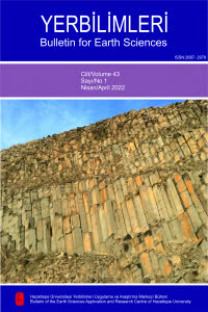Demirtaş-Alanya yöresinde Alanya naplarının metamorfizmasına ilişkin yeni mineralojik bulgular
Demirtafl-Alanya çevresinde yüzeyleyen Alanya Metamorfitleri (Alanya Birli¤i) alttan üste do¤ru Mahmutlar (Permiyen ve Permiyen öncesi), Sugözü ve Yumruda¤ (Permiyen-Triyas) naplar›ndan oluflmaktad›r. Mahmutlar Nap›, üst seviyelerden (fillit, metasilttafl›) alt seviyelere (granat-mika flist) do¤ru artan metamorfizmaya ba¤l› olarak, 2M1 serizitik mika, IIb klorit (klinoklor), 2M1 beyaz K-mika ve 1M biyotit biçiminde ilerleyen bir evrim geçirmifltir. ‹deal muskovit-fenjitik beyaz K-mikalar orta bas›nç-düflük bas›nc›n yüksek kesimlerini karakterize eden b0 de¤erlerine sahiptir. Sugözü Nap›, metabazit (eklojit, glokofan flist) arabantlar› ve/veya mercekleri içeren granat-mika flistlerden oluflmaktad›r. Muskovit, ripidolitik IIb klorit, ender olarak paragonit, illit-smektit ve smektit türü fillosilikatlar içeren metapelitlerdeki fenjitik mikalar›n kristalinite de¤erleri epizonu, b0 de¤eri ise, orta bas›nç fasiyesini temsil etmektedir. Yumruda¤ Nap›, kloritoyid ve paragonit, eser miktarda 1Tc pirofillit, kaolinit/dikit ve margarit gibi indeks ve/veya ay›rtman mineralleri içermesiyle karakteristik olup, Toros kufla¤›n›n kuzey kesimindeki Bolkarda¤ ve Alada¤ birliklerine benzer bileflime sahiptir. Bu napta epimetamorfik 2M1 K-mikalar ideal muskovit-fenjit, IIb kloritler ripidolit bileflimindedir. K-mikalar›n b0 de¤erleri düflük bas›nç-orta bas›nç fasiyesi serisinin düflük kesimini iflaret etmektedir. Naplar birbirinden farkl› bileflim ve metamorfizma karakteri sergilemektedir. Mahmutlar Nap› ile daha önce yüksek bas›nç/düflük s›cakl›k metamorfizmas› geçirmifl olan Sugözü Nap›, daha sonraki bir evrede P-T-t yönünde ilerleyen Barroviyen tipi metamorfizmaya u¤ram›fllard›r. P-T-t’nin tersi yönünde metamorfizma geçirmifl olan Yumruda¤ Nap› bu naplar üzerine daha sonra yerleflmifltir. Naplaflma hareketleri, buruflma k›vr›m ve dilinimi ile, milonitik dokunun yan› s›ra, kloritoyid, ripidolitik klorit, klorit-smektit, klorit-vermikülit ve illit-smektit oluflumlar›na da neden olmufltur.
New mineralogic data on the metamorphism of the Alanya nappes, Demirtaş-Alanya, Central Taurus
he Alanya Metamorphics cropping out in the Demirtafl-Alanya area consist of Mahmutlar (Permian and Pre-Permian), Sugözü and Yumruda¤ (Permian-Triassic) nappes from bottom to top. Mahmutlar Nappe shows a progressive evolution as; 2M1 sericitic mica, IIb chlorite (clinochlore), 2M1 white K-mica and 1M biotite related to increasing metamorphism from upper (phyllite, metasiltstone) to lower part (biotite schist and garnet-mica schist). ‹deal muscovite-phengitic white K-micas have b0 values that are characterized by a facies series of the medium pressure to upper part of the low pressure metamorphism. Sugözü Nappe is made up garnet-mica schist including metabasite (eclogite, glaucophane schist) interbands and/or lenses. The crystallinity and b0 values of phengitic micas in the metapelites, including phyllosilicates such as muscovite, ripidolitic IIb chlorite, rarely paragonite, illitesmectite and smectite, represent epizone and medium pressure facies conditions, respectively. The Yumruda¤ Nappe is characterized by its bearing the index and/or indicator minerals such as chloritoid and paragonite, traceamounts of 1Tc pyrophyllite, kaolinite/dickite and margarite, and have similar composition with Bolkarda¤ and Alada¤ units of the northern part of the Taurus Belt. Epimetamorphic 2M1 K-micas and IIb chlorites have compositions of ideal muscovite-phengite and ripidolite, respectively. b0 values of K-micas indicate a facies series of low pressure to lower part of medium pressure metamorphism. The nappes exhibit different lithologies and metamorphic features. The Sugözü Nappe displaying an earlier high pressure/low temperature metamorphism has been overprinted together with the structurally overlying Mahmutlar Nappe by a later Barrowian-type metamorphism. The Yumruda¤ Nappe, on the other hand, is characterized by a metamorphic evolution with a typical anticlockwise P-T-t path, indicating that its emplacement on the other nappes is relatively late. The formations of crenulation fold and cleavage, mylonitic texture together with the crystallization of chloritoid, ripidolitic chlorite, chlorite-smectite, chlorite-vermiculite and illite-smectite in the Yumruda¤ Nappe is assumed to be due to this later nappe-movement.
